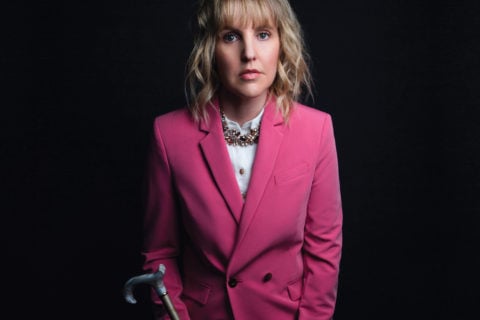How an MS Diagnosis Affected My Attitude Toward Fashion
Whenever I couldn’t sleep pre-COVID, I put together outfits in my mind. I thought about an event I had on the horizon – a trip to New York, an upcoming opera, dinner with friends – and mentally scanned my closet in search of the perfect tulle skirt, velvet blazer or knee-high boots that I could build the rest of my look around. Some people count sheep, but I am soothed with visions of all the pretty things in my wardrobe that are begging to be brought to life.
I’ve had multiple sclerosis (MS), an incurable chronic illness, for 19 years. For most of this time, I knew my life was going to be difficult, but I had faith in who I was and believed my diagnosis couldn’t change that. But as my disease progressed, slowly and insidiously, there came a day when MS was no longer just something I had (an illness); it was something I was (disabled).
The forces attempting to erode my sense of self went beyond what MS can do. Adding a cane and then a rollator, and sometimes a wheelchair, to my day-to-day look was not part of my insomniac dreams but an unexpected nightmare for my identity. I went from being able to pass as “normal,” where a stranger commenting on my appearance would likely be complimenting my red leather loafers or raw-silk turban, to feeling like I was wearing a sign inviting people to ask “What’s wrong with you?” or “Can I pray for you?”
For most of my life, my style was the first thing that spoke for me – a style I thought of as chic meets whimsical, never boring and always a little bit “look at me.”
When the effects of MS forced me to add mobility aids to my wardrobe, it suddenly didn’t matter how loud my statement necklace was; my disability was the first thing that spoke for me, and it had nothing good to say. I found myself shoving my rollator out of photos and surfing the walls and furniture at home rather than have my husband see me using a cane. I was convinced that looking fall-down drunk was still more appealing than looking disabled. Of course, my husband is no fool. I looked drunk and disabled – and probably a little stupid.
I wanted the world to keep seeing me the same way I saw myself. But even my vintage pink boa couldn’t detract from the pitying looks and inquiries that being attached to a rollator invites. People don’t believe you can be attractive, successful, sexual or even smart if you have a disability. I was freaking out and, for the first time in my life, unsure of who I was.
I wanted the world to keep seeing me the same way I saw myself.
It was during this self-indulgent existential crisis that I found myself strolling through my downtown Toronto neighbourhood when a guy about my age, wearing a natty fedora, walked toward me. Like me, he was using a cane. I noticed his drop foot, and I saw him notice mine. We gave each other knowing smirks as we headed in opposite directions. I ruminated over Fedora for days, thinking “That guy seemed cool; I could be friends with someone like that.”
And then it struck me. Like, duh, if that guy looks cool with a mobility aid, maybe I look cool, too. I realized that the key to accepting my new look – the mobility aid version of myself – was in seeing people who look like me looking better than me. So much of fashion is aspirational. How was I supposed to understand the potential beauty of someone with a disability without high-fashion examples to consider?
I turned to the internet in search of new role models. (Selma Blair’s red carpet moment at the 2019 Vanity Fair Oscar party, when the actress appeared in a flowing Ralph & Russo gown with a customized matching cane, hadn’t happened yet.) The absence of stylish images of visibly disabled young women in mainstream media validated the negative associations I assumed were being made about me. I felt like I’d been excommunicated from the world of designer clothes and It bags that I loved so much.
I decided that I would not only stop being ashamed of my mobility aids but also celebrate them.
Coming to terms with my inability to walk unaided is an ongoing negotiation, but my North American birthright to superficial vanity and materialistic self-obsession is no longer negotiable. My new disabled identity isn’t going to keep me from my “look at me” outfits. I decided that I would not only stop being ashamed of my mobility aids but also celebrate them.
I sourced the best-looking devices I could find – no small feat considering that just about every industry has yet to recognize that people with disabilities have the same fashion literacy as the average consumer. The idea that disability is the only identity we’re entitled to is reinforced when the tools we need to help us move look so medical, devoid of aesthetic or individuality.
It is just another way to be human, and how can we not find beauty in that?
I found two companies in Europe (naturally!) that were making rollators that matched my vibe. Sleek and stream- lined, they had hidden cables, making them look more sporty than assistive, and they came in colours like Oyster White and Cloud Blue. I hired a fashion photographer to create the kind of images I had been looking for – for my own sake but also so I could litter them all over Instagram, knowing there had to be other people looking for the same kind of mirror I had been seeking.
Since my initial online searches in 2017, the virtual chronic illness community has expanded and social media has become a place where people with disabilities can see and be seen and are unapologetically taking up space. The landscape is changing, and the new fashion industry has started to take notice.
I used to be happy to pass as “normal,” but with 22 per cent of Canadians identifying as disabled, disability is normal. It is just another way to be human, and how can we not find beauty in that? In the end, MS didn’t make me change my style. It made me insist on my style, and my “look at me” attitude has never felt more powerful.








